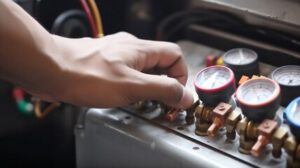Refrigeration Troubleshooting Basics
If you notice puddles of water inside or outside your fridge, the first thing to do is shut off the power and remove the rear access panel. Look for obstructions in the drain tube and signs of excessive wear on the fan motor.
Leaking refrigerant can also be the result of loose or broken line sets. These are easy to check and fix with a wrench. If you can’t find a solution, it might be time to click here at https://alltemprefrigerationfl.com/ for a professional refrigerator repair service.
 Check the Power
Check the Power
While this may seem obvious, many refrigerator issues begin with a lack of power. Check the power source first to make sure the fridge is plugged in and that the outlet works. If you have other appliances plugged into the same outlet, try one of them to see if it is still working.
If it is not, the next step is to check the fridge for a tripped breaker. A tripped breaker shuts off the flow of electricity to the refrigerator, stopping it from running and possibly causing a short circuit. You can test the outlet voltage with a multimeter, but be careful – electrical components like capacitors retain a charge and could electrocute you.
Another common problem is a defective light bulb or broken socket. A refrigerator light is a standard 120-volt lightbulb with an incandescent filament that lights up when you open the refrigerator door or press a button on the refrigerator control panel. A defective lightbulb can sometimes be fixed by removing the old one and replacing it with a new one, though you should note that this will not restore cooling functions.
In addition to checking the bulb, make sure the socket is intact and that the light switch on the refrigerator control panel is on. The switch is usually a small push-button on the face of the panel and is labeled as “Refrigerator.”
A dirty drain pan or clogged drain tube can also interfere with the refrigeration process. If water pools outside the refrigerator it is likely due to a dirty drain pan, which can be cleaned by forcing hot water or a solution of baking soda and bleach through the tube with a turkey baster.
It is important to note that a new refrigerator can take 24 hours or more to start cooling, depending on how full it is and the ambient temperature. If this is the case, be patient and consult your owner’s manual for brand-specific troubleshooting tips. If the refrigerator is still not cooling after 24 hours, it is probably time to call a professional.
Check the Evaporator
A working evaporator coil in your air conditioning system is crucial to its ability to remove heat from the inside of your home. It takes the warm air in your refrigerator and freezer compartments and passes it over the coil to cool the air before bringing it out through the vents. If there is a problem with the evaporator, it will fail to remove heat from the air and your refrigeration won’t work.
Typically, your evaporator fan is supposed to run as soon as the compressor turns on and to continue running until the refrigerator or freezer compartments are fully cooled. However, some issues may prevent the evaporator fan from running and could require professional HVAC service to repair or replace it.
The first thing you should check if the evaporator fan isn’t running is for any physical obstructions to the fan itself. If there is any ice build-up, it can hinder the fan from operating correctly and needs to be removed. You should also check for any broken wires or a faulty electronic control board that will need to be replaced.
You’ll have to disconnect the refrigerator power cord from its electrical outlet for safety reasons to get to the evaporator fan and unplug it. Once it is disconnected you’ll need to drop the back freezer panel and look for two wires that are hooked up to the evaporator fan. These are usually red and blue wires that will be connected to the plug harness. You should then be able to conduct a continuity test on the wires using your multimeter. If the wires don’t read zero ohms, they will need to be replaced.
If you’re not familiar with the inner workings of your air conditioner, it isn’t uncommon to have a hard time understanding what goes on behind the scenes to make your home cooler. However, understanding how the evaporator coil and suction line work together will help you troubleshoot your AC when it doesn’t perform as expected.
Check the Condenser
The condenser, like the evaporator and compressor, is crucial to your fridge’s operation. If it can’t perform its job, the fridge won’t cool and you won’t have cold food. The trouble with the condenser is usually due to a faulty or broken fan blade or clogged or dirty coils. You may also need to clean the condenser coil or replace the fan motor. If the problem is a fan blade, you can test it by pushing on the blade. If it doesn’t turn, the motor is seized and will need to be replaced.
You can check the condenser with a voltmeter, which is an electronic tester that lets you know the state of your refrigerator’s electrical system. First, make sure the high-pressure safety isn’t open, which can be caused by an excessive amount of refrigerant in the system or a blocked or leaking condenser coil. Then, check the airflow over the condenser coil and determine if the temperature of the coil is too low. Finally, measure the standing pressure of the high side and if it’s too high or lower than normal, this could be an indication that the system is contaminated with air and non-condensible or that it has mixed refrigerants.
Another way to check the condenser is by watching for green fluid around your car’s compressor; this could mean that the part is leaking. This is common, as seals can crack or break with normal wear and tear or from physical damage from road debris.
You can also use a stethoscope to listen to your refrigerator. If you hear a constant and loud humming sound that doesn’t stop, this is a sign of a faulty compressor. A faulty compressor may also cause a clogged or frozen evaporator coil or a damaged or stuck fan blade. It’s important to perform regular maintenance on your fridge, including vacuuming the condenser coil and evaporator coil, replacing the evaporator fan blade twice per year, and cleaning the refrigerator coils with a commercial degreaser at least once a year. Also, don’t forget to change your refrigerant every five years or so and calibrate your temperature sensors once a year.
Check the Fan
If your refrigerator is cooling just fine but isn’t freezing, the problem might be something as simple as the freezer fan. Alternatively, the problem could be with the defrost timer, defrost heater, or defrost thermostat, and replacing these parts may be necessary. Fortunately, these are all components that you can test yourself with a multimeter.
If the fridge cycles on and off, or isn’t turning on at all, this could be a sign that the compressor relay and compressor motor are faulty. However, before you spend money on a new one, first try a few refrigerator troubleshooting solutions.
The first thing to do is check the refrigerator’s power supply. Make sure the fridge is plugged into a live receptacle that’s receiving electrical power (try plugging in a working lamp or outlet circuit tester). Also, if you use an extension cord to connect your fridge to the outlet, check that the cord has no cuts, exposed wire, or kinks. Replace the cord if it has any of these problems.
Another problem that could cause the fridge to cycle on and off is a clogged drain tube. These tubes route excess moisture from the evaporator coils to the pan underneath the fridge, where the fan blows over it to disperse the water. The evaporator fan can sometimes get clogged with lint and debris, which limits airflow. If the fan is causing a banging sound, disconnect it from the fridge and remove its cover plate. Brush or rag the fan to remove any debris and restore proper function.
Finally, if the freezer isn’t cooling but the fridge is, the problem is probably either frost-clogged evaporator coils or a stuck or broken evaporator fan. The evaporator coils and fan are located behind the freezer wall and can be easily checked for clogs or damage by unplugging the fridge, removing the panel, and examining the inside of the freezer. The evaporator fan can usually be tested with a multimeter.
A properly functioning refrigerator is essential for storing food, drinks, and household products. It can be frustrating when it stops working, but often the problem is very easy to diagnose and fix.
